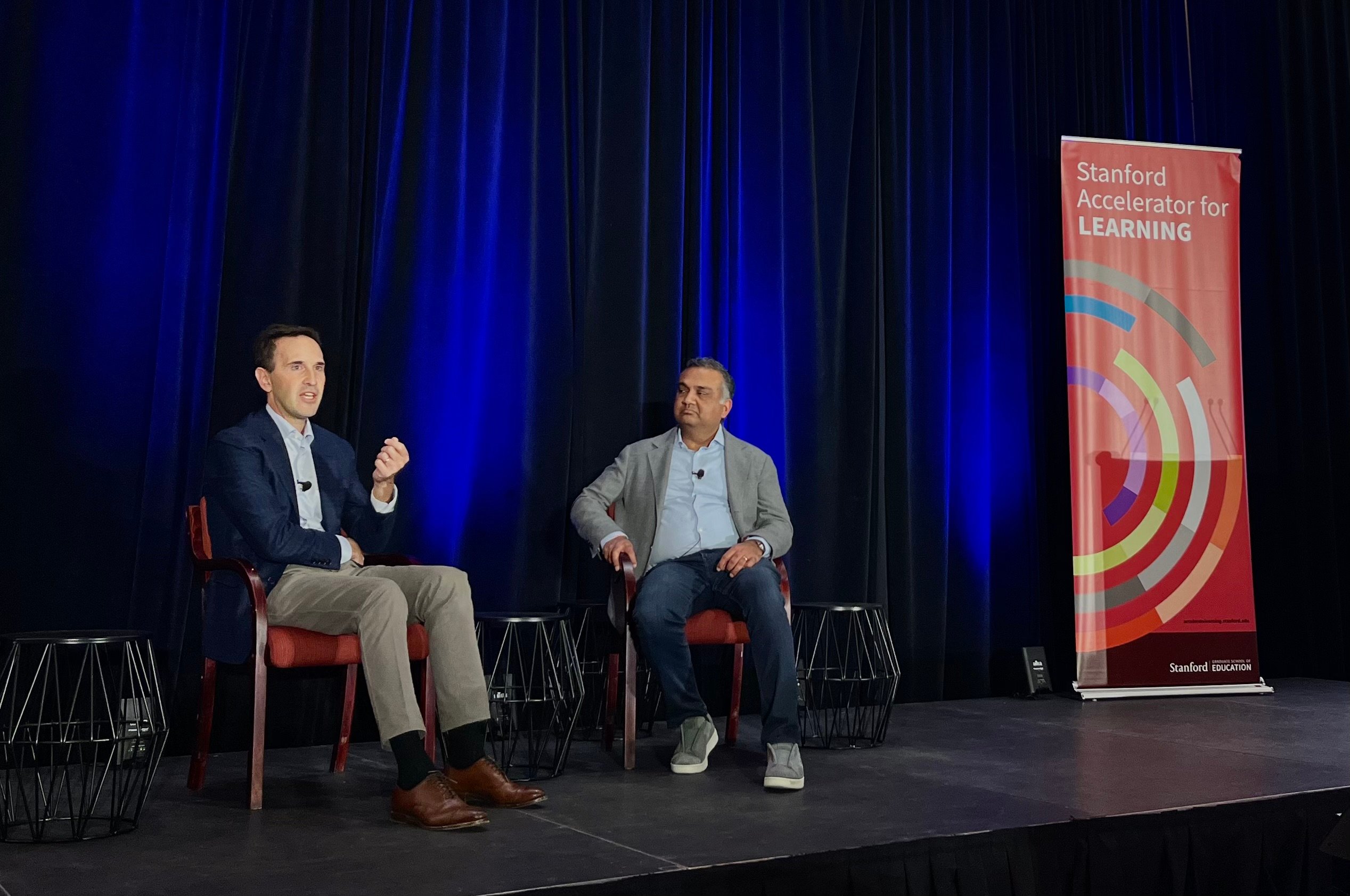In the age when Khan Academy lessons and lectures from top universities are available online, YouTube’s CEO Neal Mohan ’96 MBA ’05 and Stanford President Jon Levin ’94 explored the value of traditional educational institutions at the 2024 Accelerate Edtech Impact Summit on Monday.
Organized by the Stanford Accelerator for Learning, the summit held at Arrillaga Alumni Center followed the success of the inaugural 2023 event, gathering 400 thought leaders across research and industry to cross-pollinate ideas on the design of learning, especially in the age of AI.
Acknowledging the expanding role that YouTube plays as an educational tool in the U.S. and around the world, Mohan shared recent initiatives that seek to facilitate education purposes on the site. “Courses” is a functionality for educational creators to curate playlists of their own videos to organize pedagogy effectively, and “Study Hall” is a set of online course videos that grant college credit, made in collaboration with Arizona State University and education YouTube channel Crash Course. A feature called “Player for Education,” an embedded player that is free of ads, links and recommended videos, allows classroom teachers to control the content shown.
The products are designed to reach people who wouldn’t have had access to such course material otherwise, Mohan said. The COVID-19 pandemic accelerated the growth of the educational space on YouTube, increasing the number of online learning videos from hundreds to thousands. Now, YouTube covers preschool to higher education, with popular channels like Ms. Rachel and MIT OpenCourseWare.
Stanford also publishes select lectures to its YouTube channel of nearly 2 million subscribers. Stanford’s Graduate School of Business channel has nearly 3 million. Noting a video from a Stanford communications faculty that garnered 48 million views, Levin underscored how technology “opens up an incredible set of avenues for people teaching at places like Stanford and anywhere else in the world.”
Mohan also spoke on the platform’s shortcomings as an end-to-end education experience.
“I do think there’s a limitation to what YouTube can do here. We have a specific role, but by no means are we the full picture.” Mohan said. “It doesn’t provide the actual connection with the professors, the classroom teachers or the certification, but it can be a tool to augment what’s happening.”
Levin agreed with this sentiment, saying that while online higher education programs have built in successful models for teaching and learning, a lot of education is about the broader experience, which includes interactions with peers.
“There’ll still be a whole set of skills where you learn how to sit and sort things out with people, which is such an important skill in life,” he said. “I think this will take a long time to change. So we’ll see some of the things that have always mattered will continue to matter and that’s going to be a great next decade in education.”
Reflecting Stanford’s environment specifically, Levin said innovations in pedagogy induced opportunities unchanged by technological advancements. Notably, Levin pointed to the introduction of the COLLEGE requirement for freshmen as an educational feature irreplaceable by technology.
“At a place like Stanford, I tend to think of educational technology as being a complement to what we do rather than a substitute,” Levin said. Referring to COLLEGE, he said that the required freshman class taught by faculty members is “one of our biggest innovations.”
“It’s a great model of education to sit around the table and talk to faculty who have great things to say,” Levin said.
While YouTube doesn’t have plans to virtualize the interactive experience inherent in traditional education settings, Mohan spoke on the platform’s vision of personalizing learning experiences with AI. On Android, YouTube has already rolled out an interactive chatbot beneath educational videos to guide learners through socratic dialogue.
Mohan is also bullish on the future of generative AI-enabled audio translation, which can match speakers’ intonations and lip movements to engage learners who speak different languages. He said the technology is only months away from launching.
The conversation was the final speaker event of the summit, which included a showcase of cutting-edge research, cross-industry panels, edtech startup competition and a fireside chat with Ben Gomes, senior VP at Google, and Jim Shelton, former U.S. Department of Education Deputy Secretary. The fireside chat was led by Dan Schwartz, dean of the Stanford Graduate School of Education.
Schwartz, who directed the summit, spoke on the Summit’s goal to facilitate discourse between those of different perspectives. Panelists came from different sectors, so both a teacher and a tech entrepreneur could discuss the advent of generative AI intertwined with scale, for example.
“I think edtech could do a lot. It hasn’t been realized,” Schwartz said. “The design of the summit to enable different stakeholders to talk with each other is to get the researchers and industry working closer and realize the really good edtech products that solve the problem of how people learn.”
At the event, there are already signs of such collaborations occurring. The winner of the summit’s domestic startup contest, Xuan Zhao, co-founded Flourish Science, an AI mental health and well-being companion for college students, alongside Julie Cachia Ph.D. ’24. Zhao was a Ph.D. exchange student at Stanford from Brown in 2015 and is now a Stanford research affiliate.
“I can really feel this energy for AI and for education,” Zhao said, after the summit’s close. For her, Levin and Mohan’s discussion of the specific balance between “ed” and “tech” onstage helps her “see a bigger, bigger picture.”
